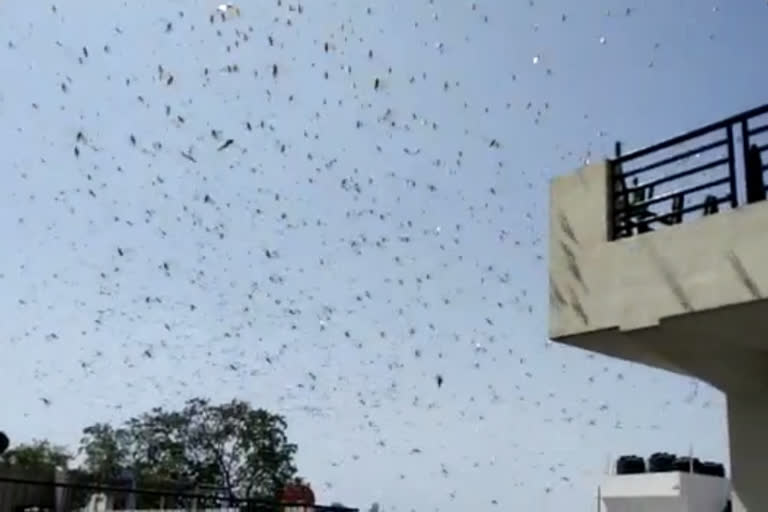New Delhi:Indian farmers will continue to face swarms of millions of plant-eating locust coming from across the border that may destroy their crops and endanger livelihood if they are not controlled soon.
A top official in the Union government’s Locust Warning Office told ETV Bharat that authorities were using drones and tractor-mounted sprayers in the locust control operations during the night when these locust swarms rest.
It is nearly a month when these gross and plant-eating locusts started arriving in India in large numbers, having 1 to 1.5 million locusts in just one swarm.
These swarms overwhelmed the cities and towns in different regions of Rajasthan before they turned towards Madhya Pradesh, which is the second most affected state from these plant-eating pests of grasshopper family.
The locust swarms also damaged crops in Gujarat, Punjab and some parts of Uttar Pradesh.
“These locusts started entering in India from April 30 onwards and so far 23 locust swarms have entered the country,” said Dr KL Gurjar, Deputy Director in the Locust Warning Office (LWO) in the Ministry of Agriculture and Farmers Welfare.
“Now they have moved from Rajasthan to Madhya Pradesh and Uttar Pradesh also,” Dr KL Gurjar told ETV Bharat explaining the direction of their movement as they flood the skies of several villages and towns across north-west India.
“Wherever they settle in the night we follow them and carry out our control operations. We are reducing their numbers day-by-day through our control operations,” informed Dr. Gurjar.
At present, control operations are going on in Rajasthan, Madhya Pradesh, Uttar Pradesh, Punjab and Gujarat.
He says earlier locust swarms have also reached Gujarat but now their spread in the state has been contained.
“Earlier there were reports of locust swarms in Gujarat but now there is no report of locust swarms from the state,” Dr KL Gurjar noted.
The authorities have now concentrated their locust control operations in three states – Rajasthan, Madhya Pradesh and one district in Uttar Pradesh.
According to officials, 23 locust swarms have entered the country in the last four weeks, which means on an average 5 locust swarms having 1.5 million locusts in each swarm are reaching the country in a week.
Drones deployed in locust control operations
Both the central and state authorities are participating in these locust control operations. Officials in the ministry of agriculture say that more than 200 people from the Locust Warning Office (LWO) have been deployed in these locust control operations and 47 teams have been formed to track down the locust swarms and spray pesticides on them.
These teams are also taking the help of local and state authorities.
“We are using tractor-mounted sprayers and other equipment from local agricultural authorities while doing our control operations,” the senior official in the locust warning office told ETV Bharat.
In addition to using tractor-mounted sprayers, the authorities are also using drones for locust control operations. These drones are not just used for monitoring the movement of locusts, but drones have also been used in spraying pesticides on them.
“We started with two drones and by Friday, we will add two more drones to our control operations,” said Dr. KL Gurjar.
Pesticide not to harm humans
Dr KL Gurjar also rules out any harm to humans due to the use of pesticides to control locusts that have swarmed the large swathes of states like Rajasthan and Madhya Pradesh.
“The pesticide degrades within 24 hours of spraying, therefore, there is no risk of high residual transmission to humans,” explained the officer, adding that there was no risk to crops due to the use of pesticides.
He, however, warns that people should cover their faces and bodies when pesticides are being sprayed on locust swarms in their vicinity.
